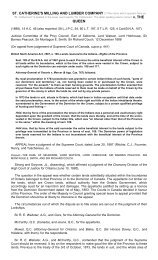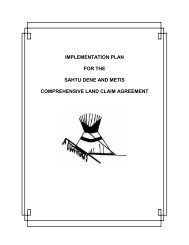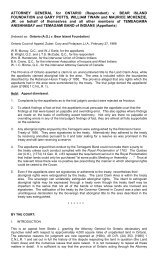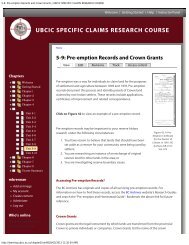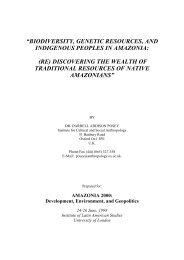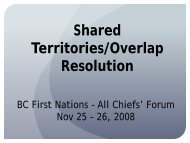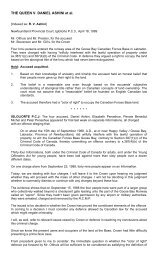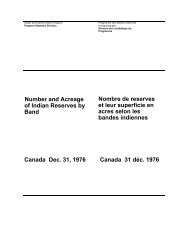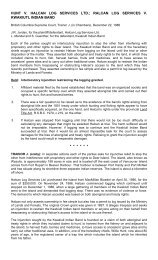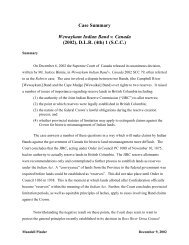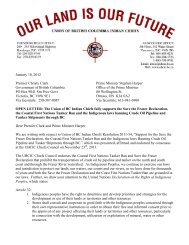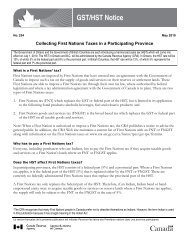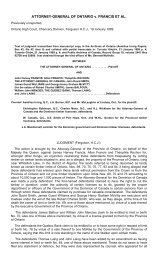Constitutional âPropertyâ and Reserve Creation: Seybold Revisited
Constitutional âPropertyâ and Reserve Creation: Seybold Revisited
Constitutional âPropertyâ and Reserve Creation: Seybold Revisited
Create successful ePaper yourself
Turn your PDF publications into a flip-book with our unique Google optimized e-Paper software.
10 MANITOBA LAW JOURNAL VOL 32 NO 1of public l<strong>and</strong>s. But no such question truly arises under the doctrine of interjurisdictionalimmunity. Put more accurately, the issue is whether the federalgovernment is exercising a power that includes a power in relation to Crownownership of property. The provision of the Constitution must itself be readpurposively, <strong>and</strong> I will not endeavour to do so any further in the abstract.V. THE S. 91(24) POWER TO “RESERVE”The power to reserve Crown l<strong>and</strong>s is said to be part of the Royal prerogative. Infairness, the question of whether this really is part of the prerogative is an unsettledone. 34 If it does form part of the prerogative as supposed, it is likely a prerogativerelating to l<strong>and</strong>. 35 That it is a prerogative relating to l<strong>and</strong> does not, asmight be supposed, mean that it is within provincial competence under s. 109.This flows logically from the proposition that l<strong>and</strong> is not “owned” by the provinceunder that provision, but is vested in the Crown simpliciter. On the contrary,since s. 109 l<strong>and</strong>s are “administered by” the provinces, but owned by the Crownsimpliciter the question of whether Crown l<strong>and</strong>s can be reserved pursuant to prerogativeis primarily a question of legislative jurisdiction. 36Given that the federal government has express constitutional jurisdictionover “l<strong>and</strong>s reserved for the Indians” under its s. 91(24) power, it would seem tobe the obvious competent authority for creating Indian reserves. That the powerto reserve l<strong>and</strong>s for Indians is a Royal prerogative relating to Crown ownership ofl<strong>and</strong> means that s. 91(24) is also on its face about Crown ownership of property.The more complicated matter is what effect the exercise of that power mayhave on provincial s. 109 powers. The reservation of l<strong>and</strong> for Indians under theIndian Act cannot be normally construed as “disposing” of Crown l<strong>and</strong> or an at-343536For example in Ross River Dena Council B<strong>and</strong> v. Canada, [2002] 2 S.C.R. 816 at para. 3, [2002]S.C.J. No. 54, Bastarache J. [Ross River cited to S.C.R.]. All the parties agreed that the sourceof the power to reserve l<strong>and</strong>s for Indians was the Royal Prerogative. Both the trial court <strong>and</strong>a dissenting judge in the appeal court in Ross River found that either it was not based on theprerogative in the first place: [1998] Y.J. No. 63 (S.C.) at paras. 25-26 (QL), or that it hadbeen altered by statute [1999] Y.J. No. 121 at para. 56, 1999 BCCA 750 (Y.C.A.), Finch J.A.,dissenting. The Supreme Court in Ross River, per Lebel J., found that none of the existinglegislation restricted the prerogative power - but it had not yet been established that it existedin the first place as that point been conceded by the parties.Ibid. I note that in Ross River (S.C.C.) Lebel J. sources the prerogative to the treaty-makingpower because many reserves are created pursuant to treaties with Indians, whereas BastaracheJ. at para. 3 sources it to the power of Crown l<strong>and</strong>s generally.In Higbie, supra note 8, a Crown prerogative is exercised in accordance with jurisdiction underthe Constitution Act <strong>and</strong> Canada has all the prerogatives of the Crown . Also see Referencere: Criminal Code of Canada s. 1036, [1932] A.C. 98 (P.C.), in which “royalties” in s. 109 didnot include prerogatives relating to subject matter that wa s federal under s. 91.



